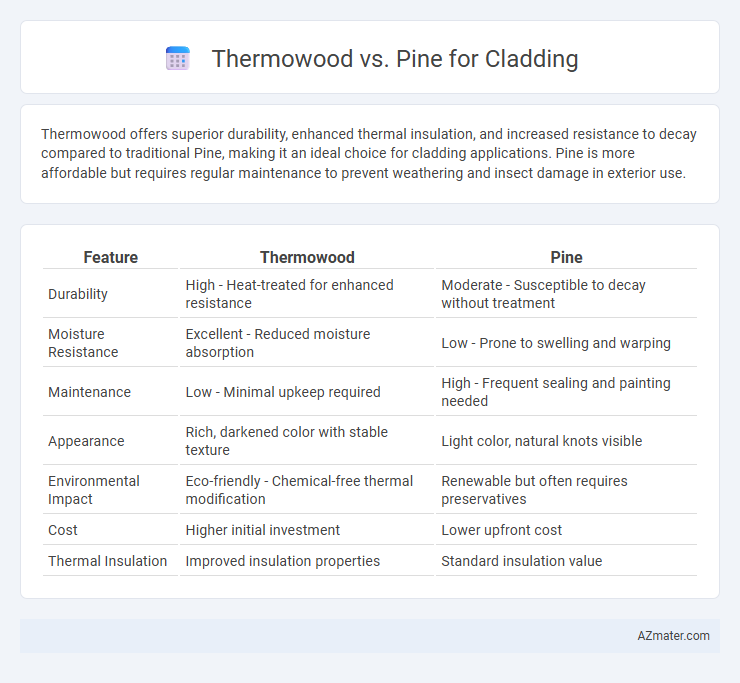Thermowood offers superior durability, enhanced thermal insulation, and increased resistance to decay compared to traditional Pine, making it an ideal choice for cladding applications. Pine is more affordable but requires regular maintenance to prevent weathering and insect damage in exterior use.
Table of Comparison
| Feature | Thermowood | Pine |
|---|---|---|
| Durability | High - Heat-treated for enhanced resistance | Moderate - Susceptible to decay without treatment |
| Moisture Resistance | Excellent - Reduced moisture absorption | Low - Prone to swelling and warping |
| Maintenance | Low - Minimal upkeep required | High - Frequent sealing and painting needed |
| Appearance | Rich, darkened color with stable texture | Light color, natural knots visible |
| Environmental Impact | Eco-friendly - Chemical-free thermal modification | Renewable but often requires preservatives |
| Cost | Higher initial investment | Lower upfront cost |
| Thermal Insulation | Improved insulation properties | Standard insulation value |
Introduction to Cladding Materials
Thermowood and pine are popular choices for exterior cladding, each offering unique benefits tied to their wood properties and treatment processes. Thermowood is modified through controlled heat treatment, enhancing durability, dimensional stability, and resistance to decay without chemical additives, making it ideal for harsh weather conditions. Pine, a widely available softwood, is cost-effective and easy to work with but typically requires protective coatings or treatments to improve its natural susceptibility to moisture and insect damage when used as cladding.
What is Thermowood?
Thermowood is a type of heat-treated pine or other softwood that has been exposed to high temperatures in a controlled environment, enhancing its durability, stability, and resistance to decay and insects. This thermal modification process reduces the wood's moisture content, making it less susceptible to warping and swelling, ideal for exterior cladding applications. Compared to untreated pine, Thermowood offers superior weather resistance and a longer lifespan, making it a sustainable and low-maintenance choice for building facades.
Understanding Pine as a Cladding Option
Pine is a popular cladding option due to its affordability, ease of workability, and natural aesthetic appeal. Its softwood nature requires proper treatment, such as pressure impregnation or protective coatings, to enhance durability and resistance to moisture, insects, and decay. Compared to Thermowood, untreated pine generally demands more maintenance and has a shorter lifespan in exterior applications.
Durability: Thermowood vs Pine
Thermowood offers superior durability compared to pine due to its enhanced resistance to decay, moisture, and insect damage achieved through thermal modification. Pine, while commonly used for cladding, is more susceptible to weathering, rot, and requires regular maintenance to maintain its structural integrity over time. Choosing Thermowood ensures a longer lifespan and lower maintenance costs, making it a more durable option for exterior cladding applications.
Weather Resistance Comparison
Thermowood offers superior weather resistance compared to traditional pine due to its heat-treated process that enhances durability and reduces moisture absorption. Pine tends to absorb water more readily, leading to faster degradation, warping, and susceptibility to mold or rot when exposed to harsh weather conditions. Choosing Thermowood cladding results in longer-lasting protection and reduced maintenance costs for exterior applications exposed to varying climates.
Maintenance Requirements
Thermowood cladding offers superior maintenance benefits due to its heat-treated process, which enhances durability and resistance to decay, insects, and moisture, reducing the need for frequent treatments. Pine cladding, while more affordable initially, requires regular sealing, staining, or painting to prevent weathering, rot, and insect damage, increasing long-term maintenance efforts and costs. Choosing Thermowood ensures a longer-lasting facade with minimal upkeep, ideal for harsh weather conditions.
Environmental Impact and Sustainability
Thermowood cladding, produced through a heat treatment process that enhances durability without chemical additives, offers a significantly lower environmental impact compared to untreated pine by increasing lifespan and reducing the need for replacement. Pine, while widely available and renewable, often requires chemical preservatives to withstand weathering, which can introduce harmful substances into the environment. Sustainable forestry certifications like FSC or PEFC are essential indicators for both Thermowood and pine to ensure responsible sourcing and minimal ecological footprint.
Cost Comparison: Thermowood vs Pine
Thermowood cladding generally incurs higher upfront costs compared to pine due to its specialized thermal modification process that enhances durability and stability. Pine is more affordable initially but may require more frequent maintenance and replacement, increasing long-term expenses. Evaluating the total cost of ownership including installation, maintenance, and lifespan highlights Thermowood as a cost-effective option despite its higher initial price.
Aesthetic Differences
Thermowood cladding offers a rich, uniform color that deepens with exposure, creating a modern and sophisticated appearance compared to the lighter, natural tones of pine, which often displays more pronounced knots and grain variations. The heat treatment process in Thermowood enhances its texture, resulting in a smoother surface and a more consistent finish that retains color longer without the need for frequent maintenance. Pine cladding can provide a traditional, rustic charm but tends to weather and age unevenly, requiring more protective treatments to maintain its aesthetic appeal over time.
Which Cladding is Right for Your Project?
Thermowood cladding offers enhanced durability, stability, and resistance to decay due to its heat-treated process, making it ideal for long-lasting exterior applications, especially in harsh weather conditions. Pine cladding, while more budget-friendly and widely available, requires regular maintenance and treatment to prevent moisture damage and insect infestations. Choosing between Thermowood and Pine depends on your project's budget, desired lifespan, and environmental exposure, with Thermowood suited for premium, low-maintenance designs and Pine suited for cost-conscious projects with routine upkeep.

Infographic: Thermowood vs Pine for Cladding
 azmater.com
azmater.com